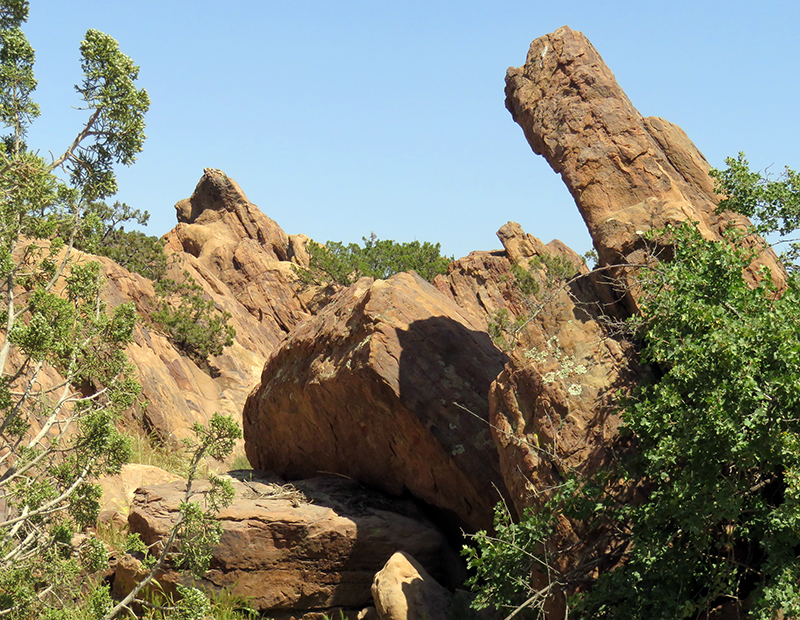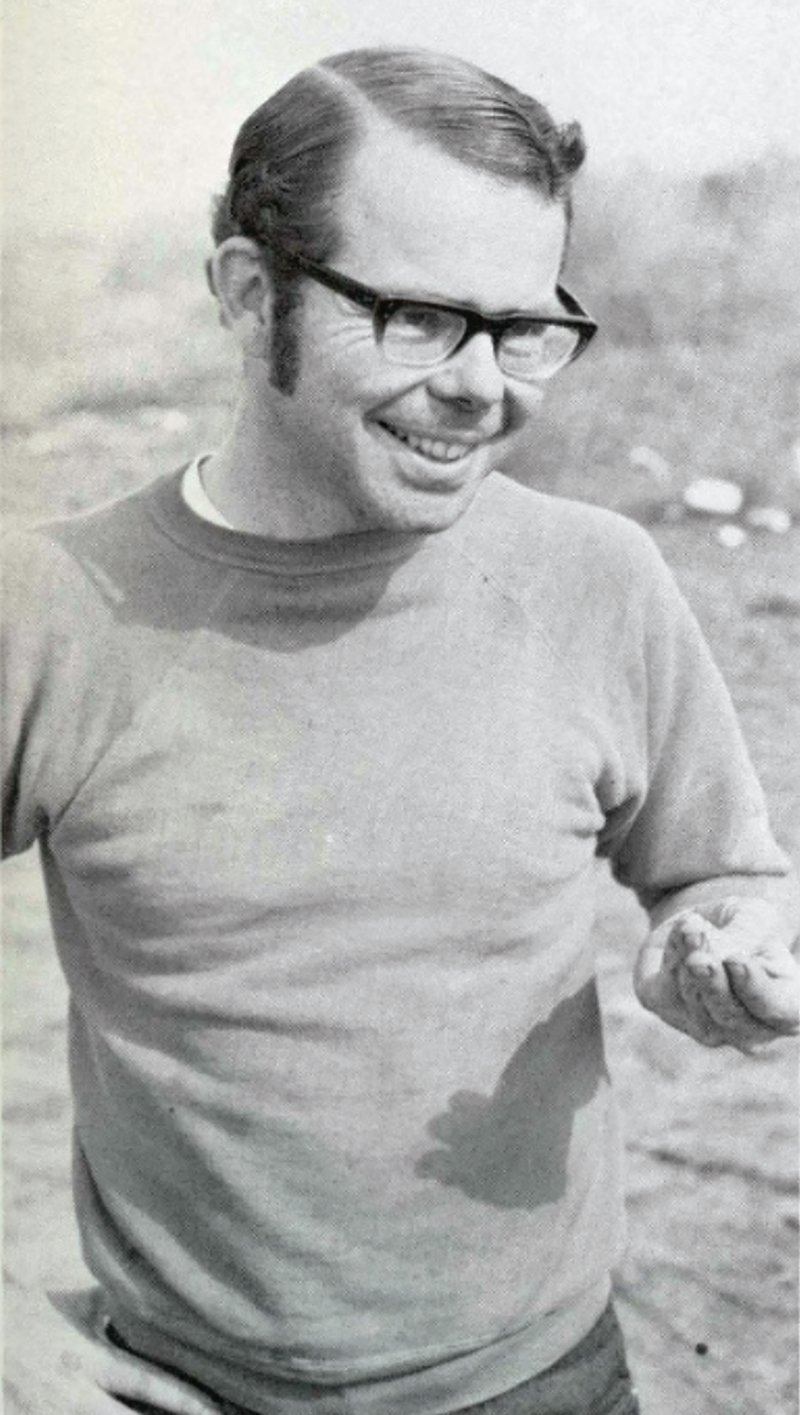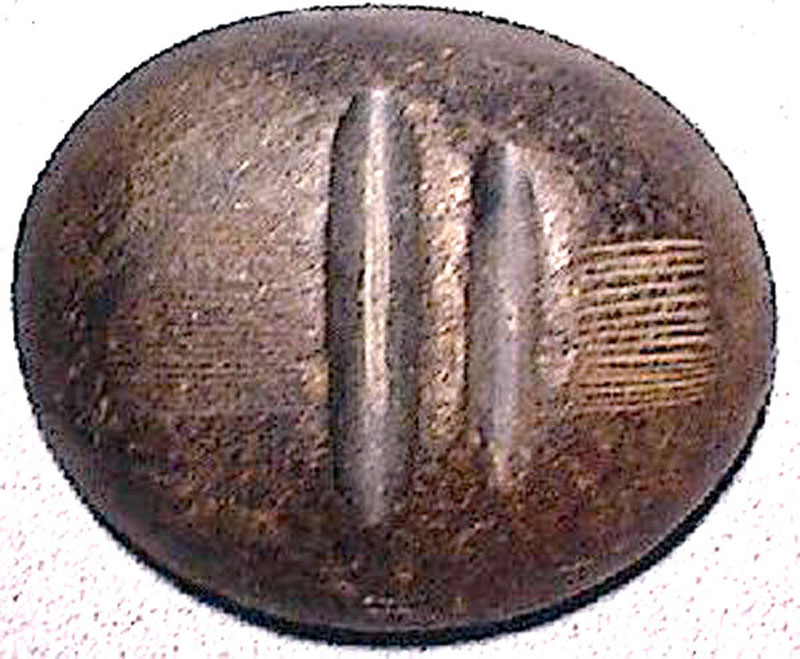|
|

|
Coiled basketry fragment, 7-inch diameter, circular and flat. Archaeological. Tataviam culture. Found by a hiker in the mid- or late 1970s in a rock shelter (small cave-like feature) at Vasquez Rocks County Park. No other material recovered. Has not been carbon-dated. Probably predates European contact (1769); certainly predates the end of the Spanish Mission period in the 1820s. The fragment, repaired while in use, is believed to be the base of storage basket that disintegrated over time. The weft material is juncus. The foundation is a deergrass bundle (Muhlenbergia rigens). The coiling direction is to the right. The fag ends (the starting end of the weft stitch) are bound under. The hiker, whose name is not recorded, gave it to his anthropology instructor at College of the Canyons, Roger Basham, at the time of its discovery. Basham recalls (pers. comm. April 2018):
It was given to me by a student who had found it while hiking in the area around Vasquez Rocks. He told me it was found in a rock depression and was rotted away in large part. What remained of the basket was the bottom. The basket was coiled, no design that I recall, but a good sample to show how a coiled basket was woven. I used to take small groups of students out to Vasquez to look at the limited rock art, and I am guessing that the fellow who found the basket might have been on one of those trips and went back out to Vasquez at a later date. He was a cross-country runner and used the area for training, if I remember correctly. I immediately put in a Riker mount due to its fragile condition — cotton inside, black fiberboard bottom and a similar top with glass viewing area to a margin of about 3/4 inch all around. Pins in the sides kept the top on the mounting box. There were no additional fragments, or they would have been put in the case, as well. Basham taught at the local 2-year community college from the time its permanent Valencia campus opened in 1970 and gave students field experience.
I started teaching a class on California Indians at COC in the early 1970s and offered it several times a year until I retired in 2007. I taught psychology, sociology, and anthropology at COC. I was the chair of the Anthropology Department and taught classes in cultural anthropology, physical anthropology and California Indians in addition to the psychology classes which I taught during my early years at COC and the sociology classes that I taught for 30 years. When the anthropology offerings reached the point of being so numerous that adjunct instructors were required, I stopped teaching sociology and put all my time into developing the anthropology program. Both Winston Wutkee and I taught at COC for 37 years. Wutkee taught geology and geography and took thousands of students on field trips in the local area, Death Valley, and the Gold Rush country. I took my classes up to Buena Vista Lake, Mutau Flats and other rock art sites, the old Southwest Museum, etc. Wutkee and I both took anthropology-archaeology classes at UCLA. I (completed) two master's degree programs in sociology before starting in with the anthropology. I did the first classes at UC Berkeley and finished up at UCLA. I have photographed numerous archaeological sites in California and throughout the Southwest. ... I used the photos (mostly slides) in both cultural anthropology and California Indian classes, along with artifacts which I collected or were donated to my program. As of April 2018, the basketry fragment is in the process of being returned to the Los Angeles County Department of Parks and Recreation for safekeeping and display in the $7 million Vasquez Rocks Interpretive Center, where other Tataviam cultural materials (stone tools) from the Agua Dulce area are displayed and described. The center opened in 2013 with the blessing of the Fernandeño-Tataviam Band of Mission Indians. (To date, this has not happened. This page will be updated if and when the artifact is returned.)
About Tataviam Basketry. When it comes to Native American basketry — woven bowls, baskets, trays, water bottles, etc. — none is rarer than basketry made by Tataviam people of the Santa Clarita Valley. As of 2018, no basketry from any era can be irrefutably attributed to a specific Tataviam individual (known by name). The closest we come is Sinforosa Fustero, the last Tataviam weaver (and speaker), who died either in 1912 or 1915, depending on the source. Three baskets in the Santa Clarita Valley Historical Society collection are sourced to Sinforosa; two of them she might have collected but did not make (one from the Lake Tahoe area, the other from Arizona), and the third is of uncertain origin. It's possible she made it. A small number of baskets, perhaps a few dozen, in private and public collections were made by known and unknown weavers in bordering areas where Tataviam individuals lived alongside people from other indigenous cultural and linguistic backgrounds (San Fernando Valley, Fillmore-Santa Paula, Tejon). The known-by-name weavers weren't Tataviam, and no unattributed basket from the borderland is recognized as distinctively Tataviam. As of 2018, all 100-percent certified Tataviam basketry is archaeological, and all was made prior to the end of the Spanish Mission period in the 1820s. By "all" we mean a dozen specimens. Twelve. Twelve for-sure Tataviam basketry items are known today. (We repeat "as of 2018" because new discoveries continue to be made.) The "Tataviam Twelve" are: * The nine storage baskets, bowls, hoppers and trays in the Peabody Museum at Harvard University. They were found by boy ranchers in 1884 in a small cache cave high up a mountainside near present-day Val Verde. They were purchased shortly thereafter by Stephen Bowers, who was collecting native California cultural materials for the Peabody. The materials, including sacred ceremonial items, were secreted in the cave — with the intent of later recovery (never effected) — most likely in 1802 or 1811, the years in which Spanish soldiers raided the local Tataviam villages and brought their inhabitants to the San Fernando Mission. Today the cave, known as Bowers Cave, is on the grounds of the Chiquita Canyon Landfill. It is not covered in garbage and probably never will be, considering its elevation. The cave has been excavated several times and is devoid of any cultural materials. All "Bowers Cave" basketry is coiled with a juncus weft on a deergrass bundle foundation (Muhlenbergia rigens), although three specimens alternate a deergrass foundation with a 3-rod juncus foundation, which is typically a Chumash characteristic. Two basketry items additionally use sumac (Rhus trilobata) as a weft material. The coiling direction is to the right, and the fag ends (the starting end of the weft stitch) are bound under. Rims are self-rims (or missing) except for one specimen with some plain wrapping. Only one basket has any decoration; it is encircled by "block-step" designs that are visible on the interior and exterior and are made of (mud-)dyed juncus. These are important diagnostic markers which are perhaps more helpful in identifying what isn't Tataviam than what is, because, other than the occasional 3-rod foundation, these traits are common to almost all basketry from the so-called "mission" region that stretches from the Santa Clarita Valley-southern Antelope Valley, on the north, to northern Baja, Mexico, on the south. Thus, the corollary: If it's a coiled basket and it doesn't have these characteristics, then it's not Tataviam. Then again, if it's a juncus basket with bound-under fag ends on a 3-rod foundation, it's highly likely to be Tataviam. (Please contact us immediately if you find such a thing.) As for the form and function of the storage baskets, bowls, trays and hoppers, they're not distinctive. The shapes and uses are fairly standard throughout the Southwest. * This twined water bottle from Piru Creek, which resides in the Los Angeles County Natural History Museum. Collected by Richard F. Van Valkenburgh in the 1930s, it is diagonally twined (up to the right) with juncus wefts on juncus warps, coated in asphaltum (local tar) for waterproofing. * A plain-twined basketry fragment from Piru Canyon, with an asphaltum coating, in the L.A. County Natural History Museum collection. Possibly also collected by Van Valkenburgh in the 1930s. On display at the La Brea Tar Pits Museum. * This 7-inch-diameter coiled basketry fragment found in the 1970s in a rock shelter (small cave-like feature) at Vasquez Rocks. Round and flat, it was probably the base to a long-disintegrated storage basket. (Vegetal material doesn't survive outside of caves, and sometimes not even then.) Like the Bowers Cave material, it coils to the right with juncus wefts on a deergrass foundation and bound-under fag ends. Privately owned by Roger Basham, retired chair of the Anthropology Department at College of the Canyons, as of 2019 it is in the process of being transfered to the L.A. County Department of Parks and Recreation for safekeeping and display in the Interpretive Center at Vasquez Rocks — from whence it came.
LW3268: Download individual images here. Photographed April 23, 2018, by Leon Worden (indoors, through glass), and December 2018 by Sarah Brewer (in daylight).
Digital images, online only.
|
Bowers Cave Specimens (Mult.)
Bowers on Bowers Cave 1885
Stephen Bowers Bio
Bowers Cave: Perforated Stones (Henshaw 1887)
Bowers Cave: Van Valkenburgh 1952
• Bowers Cave Inventory (Elsasser & Heizer 1963)
Tony Newhall 1984
• Chiquita Landfill Expansion DEIR 2014: Bowers Cave Discussion
Vasquez Rock Art x8
Ethnobotany of Vasquez, Placerita (Brewer 2014)
Bowl x5
Basketry Fragment
Blum Ranch (Mult.)
Little Rock Creek
Grinding Stone, Chaguayanga
Fish Canyon Bedrock Mortars & Cupules x3
2 Steatite Bowls, Hydraulic Research 1968
Steatite Cup, 1970 Elderberry Canyon Dig x5
Ceremonial Bar, 1970 Elderberry Canyon Dig x4
Projectile Points (4), 1970 Elderberry Canyon Dig
Paradise Ranch Earth Oven
Twined Water Bottle x14
Twined Basketry Fragment
Grinding Stones, Camulos
Arrow Straightener
Pestle
Basketry x2
Coiled Basket 1875
Riverpark, aka River Village (Mult.)
Riverpark Artifact Conveyance
Tesoro (San Francisquito) Bedrock Mortar
Mojave Desert: Burham Canyon Pictographs
Leona Valley Site (Disturbed 2001)
2 Baskets
So. Cal. Basket
Biface, Haskell Canyon
2 Mortars, 2 Pestles, Bouquet Canyon
|
The site owner makes no assertions as to ownership of any original copyrights to digitized images. However, these images are intended for Personal or Research use only. Any other kind of use, including but not limited to commercial or scholarly publication in any medium or format, public exhibition, or use online or in a web site, may be subject to additional restrictions including but not limited to the copyrights held by parties other than the site owner. USERS ARE SOLELY RESPONSIBLE for determining the existence of such rights and for obtaining any permissions and/or paying associated fees necessary for the proposed use.




































